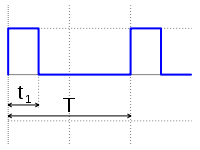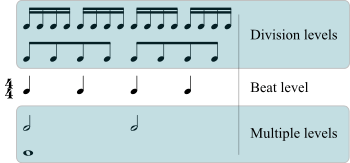Pulse (music)
In music and music theory, the pulse consists of beats[1] in a (repeating) of identical yet distinct periodic short-duration stimuli perceived as points in time[1] occurring at the mensural level. "This pulse is typically what listeners entrain to as they tap their foot or dance along with a piece of music (Handel, 1989), and is also colloquially termed the 'beat,' or more technically the 'tactus' (Lerdahl & Jackendoff, 1983)."[2] "Even a person untrained in music, can generally sense the pulse and may respond by tapping a foot or clapping."[3]

Pulse is related to and distinguished from rhythm (grouping), beats, and meter:
A pulse is one of a series of regularly recurring, precisely equivalent ["undifferentiated"] stimuli. Like the tick of a metronome or a watch, pulses mark off equal units in the temporal continuum.... A sense of regular pulses, once established, tends to be continued in the mind and musculature of the listener, even though the sound has stopped.... The human mind tends to impose some sort of organization upon such equal pulses. ...
[Pulse is] an important part of musical experience. Not only is pulse necessary for the existence of meter ["there can be no meter without an underlying pulse to establish the units of measurement"], but it generally, though not always, underlies and reinforces rhythmic experience.
Meter is the measurement of the number of pulses between more or less regularly recurring accents. Therefore, in order for meter to exist, some of the pulses in a series must be accented—marked for consciousness—relative to others. When pulses are thus counted within a metric context, they are referred to as beats.
Definitions


The pulse may be audible or implied. The tempo of the piece is the speed of the pulse. If a pulse becomes too fast it would become a drone; one that is too slow would be perceived as unconnected sounds.[5] When the period of any continuous beat is faster than 8–10 per second or slower than 1 per 1.5–2 seconds, it cannot be perceived as such.[5] "Musical" pulses are generally specified in the range 40 to 240 beats per minute. The pulse is not necessarily the fastest or the slowest component of the rhythm but the one that is perceived as basic. This is currently most often designated as a crotchet or quarter note when written (see time signature).
Pulse groups
While ideal pulses are identical, when pulses are variously accented, this produces two- or three-pulse pulse groups such as strong-weak and strong-weak-weak[1] and any longer group may be broken into such groups of two and three. In fact there is a natural tendency to perceptually group or differentiate an ideal pulse in this way. A repetitive, regularly accented pulse-group is called a metre.

Pulses can occur at multiple metric levels - see figure. Pulse groups may be distinguished as synchronous, if all pulses on slower levels coincide with those on faster levels, and nonsynchronous, if not.
An isochronal or equally spaced pulse on one level that uses varied pulse groups (rather than just one pulse group the whole piece) create a pulse on the (slower) multiple level that is non-isochronal (a stream of 2+3... at the eighth note level would create a pulse of a quarter note+dotted quarter note as its multiple level).
See also
Sources
- Winold, Allen (1975). "Rhythm in Twentieth-Century Music", Aspects of Twentieth-Century Music. Wittlich, Gary (ed.). Englewood Cliffs, New Jersey: Prentice-Hall. ISBN 0-13-049346-5.
- Fitch, W. Tecumseh and Rosenfeld, Andrew J. (2007). "Perception and Production of Syncopated Rhythms", p.44, Music Perception, Vol. 25, Issue 1, pp. 43–58, ISSN 0730-7829.
- Benward, Bruce and Saker, Marilyn (2003). Music: In Theory and Practice, Vol. I, p.9. 7th edition. McGraw-Hill. ISBN 0-07-294262-2.
- Cooper, Grosvenor and Meyer, Leonard B. Meyer (1960). The Rhythmic Structure of Music, p.3-4. University of Chicago Press. ISBN 0-226-11521-6/ISBN 0-226-11522-4.
- P. Fraisse, Les Structures Rhythmiques, Erasme Paris 1956, H Woodrow Time Perception in "A Handbook of Experimental Psychology", ed. S.S. Stevens, Wiley, NY 1951, both quoted at http://www.zeuxilogy.home.ro/media/manifesto.pdf Archived 2011-07-22 at the Wayback Machine (zeuxilogy.home.ro Archived 2012-03-06 at the Wayback Machine)
.png)